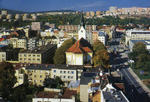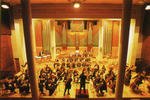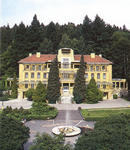
The district town Zlin lies in the valley of the river Drevnice in the midst of the Vizovicke Uplands, on the boundary of three Moravian regions - Valassko (Wallachia), Slovacko (Moravian Slovakia) and Hana.
The first written record of Zlin dates back to 1322 when the medieval town donated to
Eliska Rejcka, the Queen Widow. In the second half of the 14
th century, the Sternberk family took possesion of Zlin for a long time and the eight-pointed star in the coat-of-arms of the town in is the memory of their rule. In 1427 the Hussites conquered the town. In the 16
th century the town flourished socially and culturally. This favourable development was interupted by the invasion of Hungarian Bochkays who burned it down. Even wars the hardships brought about the Thirty Years War in the 17
th century.It lasted many years before the town recovered.
It was not until the second half of the 18
th century that the trades begun to developed and the first manufactures were established. However, the greatest economic boom began in the late 19
th century. In 1894, Tomas Bata (1876-1932), linking up with the traditions of cobblers founded a slipper manufacture. The factory grew rapidly and influenced the development of the hole town. In 1899, Zlin was connected with the railway, speeding up the development of industry. Before the outbreak of World War I., other shoe-making factories were established. In 1903, a social democratic trade union organization of shoemakers was founded here and in 1906 it organized the first strike of workers. During World War I.,
the Bata Shoe Works supplied army footwear and the shoe making industry rapidly increased. Bata organized machine production after the American model and in the 30s the company was producing machines, furniture, airplanes and other comodities. The Bata Works had a monopoly in the Czechoslovak republic (with more than 2000 shoe shops) and ranked among the foremost shoemaking companies of the world with many factories and shops all over the world. In the 20's and 30's at the same time the town grew and developed unprecedented speed- the population increased tenfold, too more than 36000. Prominent architects from Czechoslovakia and abroad participate in the stormy development: J. Kotera (the workers colonies), F. L. Gahura (urbanistic plans), Le Corbusier (the project of the regulation plan of the town), V. Karfik (the high building). Zlin became the first example of a modern garden town in Czechoslovakia before World War II.
During the German occupation of World War II., there were many illegal revolt groups in Zlin and the surroundings, towards the end of the war Zlin was heavily demaged by bombardment. Zlin was liberated on 2
nd May 1945 by the Soviet and Rumanian armies. In the 1946 elections, the communist party won in Zlin, the Bata shoe works were nationalized and their name was changed to Svit. In 1949, Zlin merged with several surrounding communities and
until 1989 was called Gottwaldov. In 1949-1960 it was the seat of the region (the Gottwaldov Region). Gottwaldov continued to be an important industrial town with new settlements being built on the outskirts. The largest housing

settlement built since the 60s, are the Jizni Svahy (the Southern Slopes). Many works originated in the film studios and laboratories in Kudlov, particularly
animated cartoons, for instance "The Rebellion of the Toys" (1946) by H. Tyrlova, the producer and dictator, "The Christmas Dream" (1946) or "The Journey into Primeval Ages" (1954) by K. Zeman, all of which are well-known in countries of all the continents.
After the velvet revolution in November 1989, most of population supported the democratic changes in the country and their wish become true, that is that on 1
st January 1990 the town got back its original name Zlin. The entrepreneuring spirit of Bata's school was rapidly revived even after 40 years of violent suppression. The engineering works in Zlin have entered succesful cooperation with foreign producers, the building industry, business and services are now mostly in the hands of private companies and entrepreneurs. In this area Zlin again occupies the superior position as compared to other towns in the Czech Republic. Zlin is the seat of universities (the Atelier of design of the University of Arts and Crafts in Prague, the Technological faculty of the Technical university of Brno), grammar schools and technical schools. There is the Bohuslav Martinu Philharmonic orchestra, a modern theatre, museum gallery, in nearby Lesna is a ZOO. The winter stadium, sports hall, swimming pools, artificial skiing slope and others are used for sports and active leasure time. Among the social and cultural events is the annual
International Festival of Films for Children, festival of brass bands and the car competitions Barum Ralye and Walachian Winter.



 Guide
Guide 





